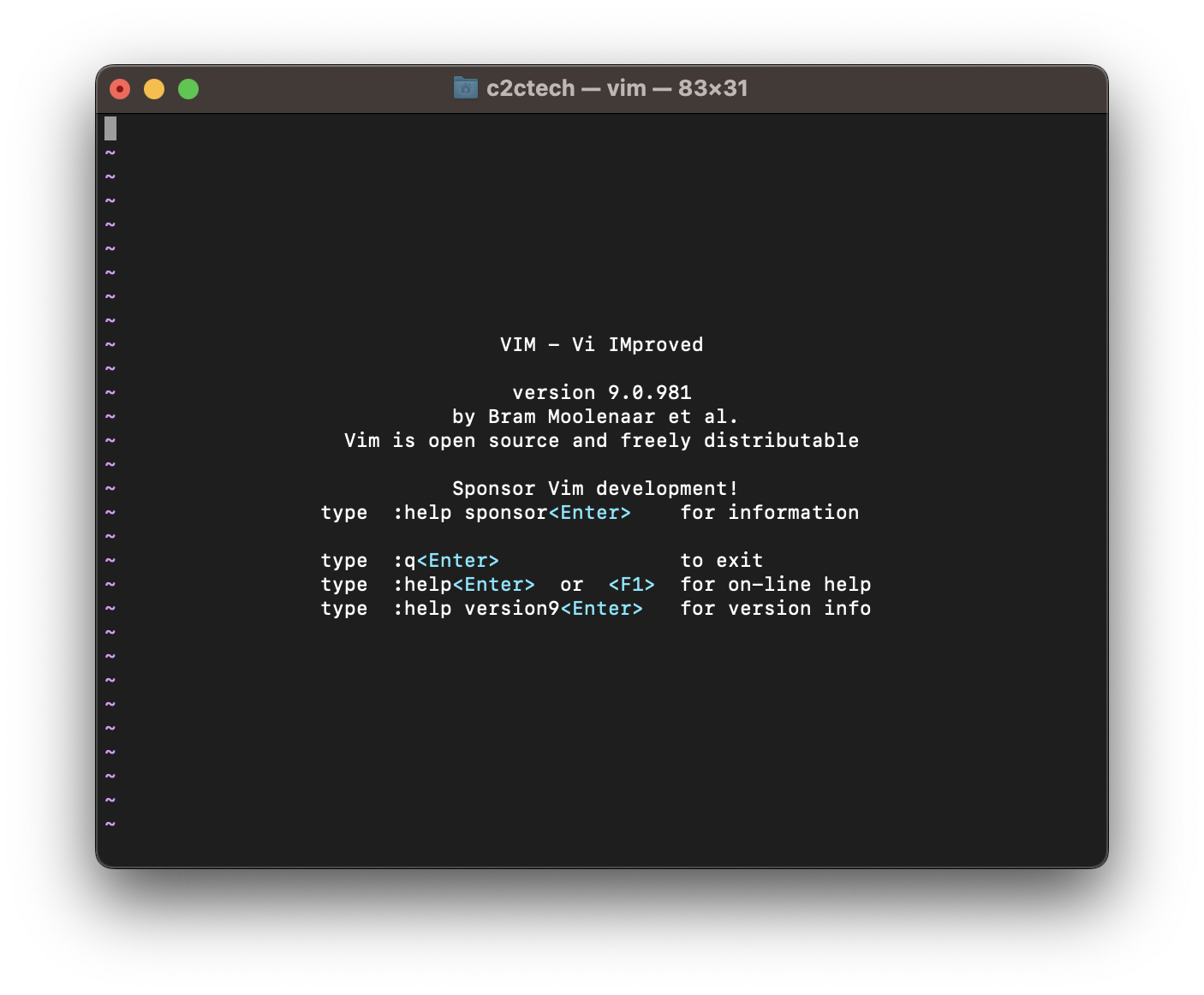
Vim is one of the most highly configurable text editors built to work with text on a Terminal/Console.
Installing Vim on Mac
- Open the Terminal Application on your Mac using Spotlight Search.
- Now type the below command to install Vim using brew,
- You would see the installation logs something like the below,
- Now type in vim in your Terminal to open the editor.
- You can check the version and more details by typing the command,
% vim --version VIM - Vi IMproved 9.0 (2022 Jun 28, compiled Dec 16 2022 23:29:16) macOS version - arm64 Included patches: 1-981 Compiled by root@apple.com Normal version without GUI. Features included (+) or not (-): +acl +file_in_path +mouse_urxvt -tag_any_white -arabic +find_in_path +mouse_xterm -tcl +autocmd +float +multi_byte +termguicolors +autochdir +folding +multi_lang +terminal -autoservername -footer -mzscheme +terminfo -balloon_eval +fork() +netbeans_intg +termresponse -balloon_eval_term -gettext +num64 +textobjects -browse -hangul_input +packages +textprop ++builtin_terms +iconv +path_extra +timers +byte_offset +insert_expand -perl +title +channel +ipv6 +persistent_undo -toolbar +cindent +job +popupwin +user_commands -clientserver +jumplist +postscript -vartabs +clipboard -keymap +printer +vertsplit +cmdline_compl +lambda -profile +vim9script +cmdline_hist -langmap -python +viminfo +cmdline_info +libcall -python3 +virtualedit +comments +linebreak +quickfix +visual +conceal +lispindent +reltime +visualextra +cryptv +listcmds -rightleft +vreplace +cscope +localmap -ruby +wildignore +cursorbind -lua +scrollbind +wildmenu +cursorshape +menu +signs +windows +dialog_con +mksession +smartindent +writebackup +diff +modify_fname -sodium -X11 +digraphs +mouse -sound -xfontset -dnd -mouseshape +spell -xim -ebcdic +mouse_dec +startuptime -xpm -emacs_tags -mouse_gpm +statusline -xsmp +eval -mouse_jsbterm -sun_workshop -xterm_clipboard +ex_extra +mouse_netterm +syntax -xterm_save +extra_search +mouse_sgr +tag_binary -farsi -mouse_sysmouse -tag_old_static system vimrc file: "$VIM/vimrc" user vimrc file: "$HOME/.vimrc" 2nd user vimrc file: "~/.vim/vimrc" user exrc file: "$HOME/.exrc" defaults file: "$VIMRUNTIME/defaults.vim" fall-back for $VIM: "/usr/share/vim"
Facing issues? Have Questions? Post them here! I am happy to answer!
Author Info:
Rakesh (He/Him) has over 14+ years of experience in Web and Application development. He is the author of insightful How-To articles for Code2care.
Follow him on: X
You can also reach out to him via e-mail: rakesh@code2care.org
More Posts related to vi,
- How to add Colors to VIM (syntax highlighting)
- How to perform Find and Replace using vim Editor
- How to update VIM version on a Mac
- How to Select All Text in Vim/Vi editor
- Guide: Install Vim on Mac
- The Vim (vi) Mac Configuration File Details
- Fix :wq! Vi Error - E32: No file name (when write and quit)
- How to Copy all text to Clipboard in Vim
- How to Uninstall Vim on Mac?
More Posts:
- How to Open a File with Notepad on Windows 10/11 - Windows-11
- How to change user image icon macOS Big Sur - MacOS
- Resolve - zsh: command not found: code - zsh
- How to add Spring Repository to Maven pom.xml - Java
- Android : Duplicate registration for activity com.example.abc - Android
- PowerShell Concatenate String Examples - Powershell
- Responsive Web Design with CSS Media Queries: A Beginner's Tutorial [Updated for 2023] - CSS
- Send Email using SharePoint PowerShell command, SMTP server - SharePoint